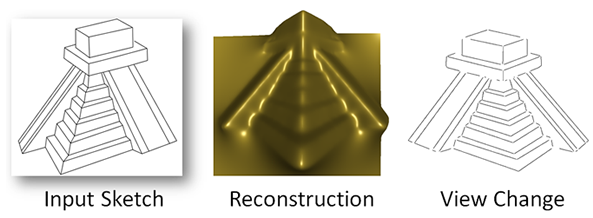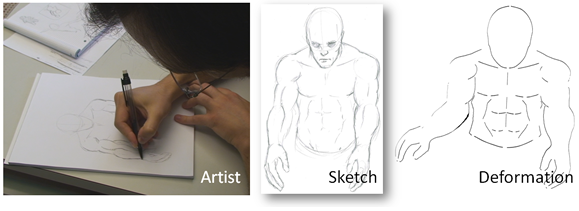3D Modeling with a Symmetric Sketch
C. Öztireli, U. Uyumaz, T. Popa, A. Sheffer, M. GrossProceedings of SBIM (Vancouver, Canada, August 5-7, 2011), pp. 23-30
Abstract
We propose a method that allows geometric operations such as view change, deformation, simulation, or symmetrization on a single off-line sketch via a proxy geometry reconstructed directly from the sketch. The reconstruction captures the overall shape of the object depicted by making use of the global relationships of the curves and the assumption that the sketched object is bilaterally symmetric. After cleaning the sketch and extracting the curves, topological and geometric properties of a set of identified points are used to derive robust correspondence and pairwise constraints. These constraints are considered all at once in a spectral algorithm to get the optimum matching of the curves. Depths of points on the matched curves are extracted by utilizing the symmetry assumption. They are then used to reconstruct a smooth geometry. The whole process is automatic except for a few seconds of user interaction.Overview
Sketch based 3D modeling allows designing very intuitive interfaces for artists. Although interactive interfaces for sketch based modeling have been constantly developing, using simple paper and pen still remains to be the most intuitive and convenient option for artists. Even when an interactive environment is used, extracting 3D information at various stages of the process aids in many applications.
Motivated by these needs, we investigated extracting 3D information and applying 3D operations on a given single off-line sketch. We showed that under the assumption that the depicted object is bilaterally symmetric, an approximate proxy geometry of the object can be reconstructed and used for various 3D modeling operations such as view change, deformation, and physical simulations.
The main contributions of our research are a matching algorithm for symmetric pairs of curves in a sketch, and a complete method that allows the user to apply 3D operations on a single rasterized sketch.
Results
Our matching algorithm can robustly match symmetric pairs of curves in a given sketch. When there are curves without symmetric pairs, the algorithm correctly identifies those and can still find matching pairs among the rest of the curves. It is also robust to impreciseness, noise, partially matching curves, and perspective distortion in the sketches.
Our method can reconstruct plausible geometries, which can then be used to apply 3D operations on the sketch.
The reconstructions can also be used to synthesize anaglyph images.
Our method allows an artist to apply deformations to his sketches.







